|
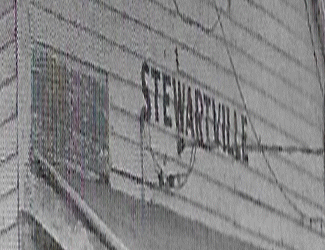
From An
Illustrated History of the People and Towns
of Northeast Shelby County
and Southeast Tipton County
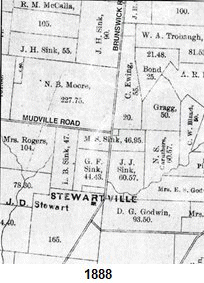 Stewartville is located just south of
Mudville via Brunswick Road, and just east
of Rosemark via Kerrville-Rosemark Road. In
the mid-19th century, John Wesley escaped
from Sanderlin farm because of maltreatment
and settled on the Donald Stewart farm;
hence his name was John Wesley Bledsoe
Sanderlin Stewart. He married Mary Hill in
the mid-1850s. They were blessed with
several children, but there first free child
was John Wesley Stewart, Jr., born June 26,
1867. The Stewart household was quite large
and the children were educated by a white
circuit teacher, Mr. William Marion, who
came from the north on horseback. He went
from house to house teaching and living with
families in the community. Each Stewart
child received a liberal education because
his home was frequented by Mr. Marion.
Eventually, their father had the foresight
and courage to petition for the first public
school in north Shelby County. The petition
was accepted and the crude school was built
on a hill where old Greenwood Church, the
church in which the Stewart family belonged,
once stood. His son, Fred, and daughters Harriette, Amanda and Ida were the first
teachers in the school. Mary Hill and John
Wesley Stewart produced the first black
doctor in north Shelby County, Dr. Fred
Stewart, a man born in slavery, but who
struggled against the odds to become an
imminent physician.
Stewartville is located just south of
Mudville via Brunswick Road, and just east
of Rosemark via Kerrville-Rosemark Road. In
the mid-19th century, John Wesley escaped
from Sanderlin farm because of maltreatment
and settled on the Donald Stewart farm;
hence his name was John Wesley Bledsoe
Sanderlin Stewart. He married Mary Hill in
the mid-1850s. They were blessed with
several children, but there first free child
was John Wesley Stewart, Jr., born June 26,
1867. The Stewart household was quite large
and the children were educated by a white
circuit teacher, Mr. William Marion, who
came from the north on horseback. He went
from house to house teaching and living with
families in the community. Each Stewart
child received a liberal education because
his home was frequented by Mr. Marion.
Eventually, their father had the foresight
and courage to petition for the first public
school in north Shelby County. The petition
was accepted and the crude school was built
on a hill where old Greenwood Church, the
church in which the Stewart family belonged,
once stood. His son, Fred, and daughters Harriette, Amanda and Ida were the first
teachers in the school. Mary Hill and John
Wesley Stewart produced the first black
doctor in north Shelby County, Dr. Fred
Stewart, a man born in slavery, but who
struggled against the odds to become an
imminent physician.
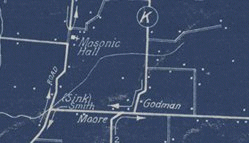 Stewartville Masonic Lodge was located on
the northeast side of where Kerrville-Rosemark
Road meets Brunswick Road, about 1.5 miles
east of Austin Peay Highway (TN 14).
Stewartville Masonic Lodge was located on
the northeast side of where Kerrville-Rosemark
Road meets Brunswick Road, about 1.5 miles
east of Austin Peay Highway (TN 14).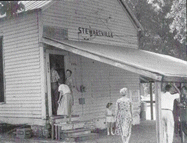 The lodge was established in 1892 and
disbanded in 1942, but thereafter the
building served as the polling place for
area residents for approximately twenty more
years. It was also the political base of
Paul W. Barret, a member of the Shelby
County Quarterly Court (now Shelby County
Commission) from 1942 through 1966 and, as
described by The Commercial Appeal newspaper
in 1966, “long the most powerful individual
in county politics.” The Stewartville voting
precinct, known as “Paul Barret’s box,”
unfailingly turned out practically unanimous
votes for the candidates endorsed by Barret
during the 1950s and 1960s. The FBI
investigated but concluded that there was no
illegal activity.
The lodge was established in 1892 and
disbanded in 1942, but thereafter the
building served as the polling place for
area residents for approximately twenty more
years. It was also the political base of
Paul W. Barret, a member of the Shelby
County Quarterly Court (now Shelby County
Commission) from 1942 through 1966 and, as
described by The Commercial Appeal newspaper
in 1966, “long the most powerful individual
in county politics.” The Stewartville voting
precinct, known as “Paul Barret’s box,”
unfailingly turned out practically unanimous
votes for the candidates endorsed by Barret
during the 1950s and 1960s. The FBI
investigated but concluded that there was no
illegal activity.
Barret’s Chapel School - Barret’s Chapel
High School, located at 1020 Godwin Road,
dates to the late 1870s. Residents of
northeast Shelby County, including
newly-freed slaves, petitioned Squire Henry
Thomas, Director of Shelby County Schools,
for school to accommodate the children in
the area. Land was given by Mrs. Jane Hays,
and a one-room school was built and named
Hays Grove in honor of the donor.
According to school history, Hays Grove was
the first school in Shelby County to hold an
eighth grade graduation exercise for black
students.
 Later,
with assistance from the Rosenwald Fund, a
four-room school was built. Miss Vivian
Bolton was the first principal of that
school. Later,
with assistance from the Rosenwald Fund, a
four-room school was built. Miss Vivian
Bolton was the first principal of that
school.
In 1922 additional land was purchased for
and an eight-room building with an
auditorium was built to accommodate twelve
grades. The name was changed to Barret’s
Chapel in recognition of J.H. Barret for his
leadership in establishing the high school.
In the spring of 1960, a fire destroyed all
buildings on the campus except the high
school building, vocational shop, and the
principal’s home. The construction of a new
cafeteria, gymnasium, and elementary was
completed in 1961. Desegregation of schools
in Shelby County during the 1960s brought
many changes. In May 1971, the last senior
class graduated. Barret’s Chapel became a
K-8 school with the 1971-72 school term.
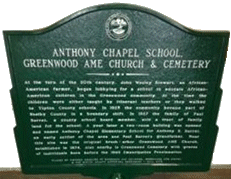 Later Anthony Chapel School was built in the
area, west of Brunswick Road and just north
of Mulberry Road, to educate
African-American children from Mudville,
Barretville and Rosemark. In May, 2015, a
historical marker was dedicated by Historic
Archives of Rosemark and Environs, Inc. and
the Shelby County Historical Commission
stating:
Later Anthony Chapel School was built in the
area, west of Brunswick Road and just north
of Mulberry Road, to educate
African-American children from Mudville,
Barretville and Rosemark. In May, 2015, a
historical marker was dedicated by Historic
Archives of Rosemark and Environs, Inc. and
the Shelby County Historical Commission
stating: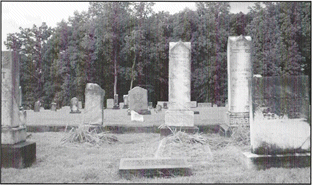
"Anthony Chapel School, Greenwood AME Church
& Cemetery. At the turn of the 20th century,
John Wesley Stewart, an African-American
farmer, began lobbying for a school to
educate African-American children in the
Greenwood community. At the time the
children were either taught by itinerant
teachers or they walked to Tipton County
schools. In 1925 the community became part
of Shelby County in a boundary shift. In
1927 the family of Paul Barret, a county
school board member, sold a tract of family
land for the school. A year later a two-room
building was opened and named Anthony Chapel
Elementary School for Anthony R. Barret, an
early settler of the area and Paul Barret’s
grandfather. Near this site was the original
brush-arbor Greenwood Cemetery with graves
of individuals born before the 1865
Emancipation Proclamation."

Greenwood Church originated as a brush-arbor
church north of Mulberry Road in either 1874
or 1878.
A wood frame building which faced the east
was constructed. At that time, Mulberry Road
was a dirt road and the road to the church
was a steep trail.
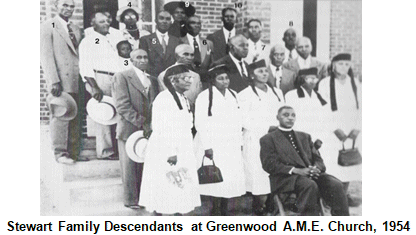 Due to the difficulty of
reaching the church grounds, the building
was torn down in 1924 and the lumber was
used to construct a new church at the
current site of the Greenwood A.M.E. Church
at 8017 Donnell Road, a more accessible
location. Due to the difficulty of
reaching the church grounds, the building
was torn down in 1924 and the lumber was
used to construct a new church at the
current site of the Greenwood A.M.E. Church
at 8017 Donnell Road, a more accessible
location.
A store owned by the Barrets that served the
families in the area was built at the
southeast corner of Brunswick Road and
Redwood Road. It was known as J.H. Barret &
Sons #5 Grocery Store and later operated by
others who lived in the area. The store had
the old grist mill brought over from the
original store, used to grind corn into corn
meal or chicken feed, depending on the
setting. Mr. Bernard Sorrells on Tracy Road
purchased the mill after its use was
discontinued.
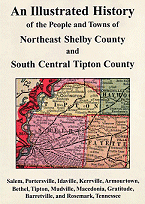 Excerpts from the jacket of An
Illustrated History of the
People and Towns of Northeast
Shelby County and Southeast
Tipton County by Historic
Archives of Rosemark and
Environs (H.A.R.E.):
Excerpts from the jacket of An
Illustrated History of the
People and Towns of Northeast
Shelby County and Southeast
Tipton County by Historic
Archives of Rosemark and
Environs (H.A.R.E.):
On October 19, 1818, the United
States Congress ratified the
treaty with the Chickasaw Nation
ceding West Tennessee to the
United States. What followed was
the creation of Shelby County
in1819 and, to its north, the
creation of Tipton County in
1823. Settlers followed quickly.
Along the border of Shelby and
Tipton counties small
communities developed around
churches, schools, and country
stores. This is the story of the
people who have lived there.
Over the last 180 years most of
the schools and some of the
towns of Northeast Shelby County
and South Central Tipton County
have disappeared. The churches
and cemeteries remain and the
land is still farmed.
This illustrated history
attempts to capture the stories
of those people and places where
they lived. Through a series of
articles and interviews, maps,
photographs, diaries, and
letters, you can experience the
people who lived on the farms
and worked in the towns of
Salem, Portersville, Idaville,
Kerrville, Armourtown, Bethel,
Tipton, Mudville, Macedonia,
Gratitude, Barretville, and
Rosemark. |
 On June 14, 2013 the Rosemark Historic
District was placed in the National and
Tennessee Registers of Historic Places by
the National Park Service the United States
Department.
On June 14, 2013 the Rosemark Historic
District was placed in the National and
Tennessee Registers of Historic Places by
the National Park Service the United States
Department.
The Historic Archives of Rosemark and
Environs is a non-profit organization whose
mission is to document & preserve historic
information & items of the Rosemark region
for educational purposes. It is primarily
responsible for the creation of the Rosemark
Historic District. Please consider a tax
deductible contribution to help them
continue these efforts.
For more
information about H.A.R.E.
www.rosemarkhistoricdistrict.com
Or, on Facebook at
www.facebook.com/RosemarkHistoricDistrict
|